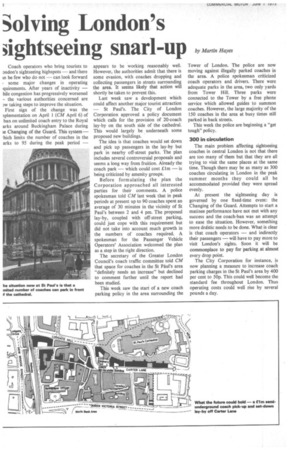solving London's
Page 20

If you've noticed an error in this article please click here to report it so we can fix it.
iightseeing snarl-up by Marlin Hayes
Coach operators who bring tourists to andon's sightseeing highspots — and there m be few who do not — can look forward
some major changes in operating quirements. After years of inactivity — hile congestion has progressively worsened the various authorities concerned are 3w taking steps to improve the situation. First sign of the change was the wlementation on April 1 (CM April 6) of ban on unlimited coach entry to the Royal arks around Buckingham Palace during ie Changing of the Guard. This system — Inch limits the number of coaches in the arks to 95 during the peak period —
appears to be working reasonably well. However, the authorities admit that there is some evasion, with coaches dropping and collecting passengers in streets surrounding the area. It seems likely that action will shortly be taken to prevent this.
Last week saw a development which could affect another major tourist attraction — St Paul's. The City of London Corporation approved a policy document which calls for the provision of 20-coach lay-by on the south side of the cathedral. This would largely be underneath some proposed new buildings.
The idea is that coaches would set down and pick up passengers in the lay-by but park in nearby off-street parks. The plan includes several controversial proposals and seems a long way from fruition. Already the coach park — which could cost Before formulating the plan the Corporation approached all interested parties for their comments. A police spokesman told CM last week that in peak periods at present up to 90 coaches spent an average of 30 minutes in the vicinity of St Paul's between 2 and 4 pm. The proposed lay-by, coupled with off-street parking, could just cope with this requirement but did not take into account much growth in the numbers of coaches required. A spokesman for the Passenger Vehicle Operators' Association welcomed the plan as a step in the right direction. The secretary of the Greater London Council's coach traffic committee told CM that space for coaches in the St Paul's area "definitely needs an increase" but declined to comment further until the report had been studied. This week saw the start of a new coach parking policy in the area surrounding the Tower of London. The police are now moving against illegally parked coaches in the area. A police spokesman criticized coach operators and drivers. There were adequate parks in the area, two only yards from Tower Hill. Three parks were connected to the Tower by a free phone service which allowed guides to summon coaches. However, the large majority of the 150 coaches in the area at busy times still parked in back streets. This week the police are beginning a "get tough" policy. 300 in circulation The main problem affecting sightseeing coaches in central London is not that there are too many of them but that they are all trying to visit the same places at the same time. Though there may be as many as 300 coaches circulating in London in the peak summer months they could all be accommodated provided they were spread evenly. At present the sightseeing day is governed by one fixed-time event: the Changing of the Guard. Attempts to start a matinee performance have not met with any success and the coach-ban was an attempt to ease the situation. However, something more drastic needs to be done. What is clear is that coach operators — and indirectly their passengers — will have to pay more to visit London's sights. Soon it will be commonplace to pay for parking at almost every drop point. The City Corporation for instance, is now planning a measure to increase coach parking charges in the St Paul's area by 400 per cent to 50p. This could well become the standard fee throughout London. Thus operating costs could well rise by several pounds a day.Tags




































































































